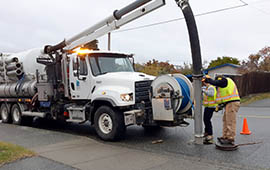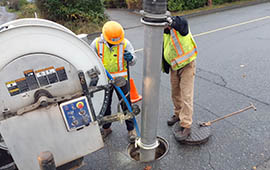
Sanitary Sewer Main Cleaning
The City performs routine maintenance to keep its sewer pipes flowing. Cleaning is done year-round, Monday to Friday between 7 am and 4 pm.
What Are Sanitary Sewer Mains?
Everything you flush down your home’s toilets and sinks goes to the sanitary sewer main. This includes wasted water from water-based appliances such as dishwashers and clothes washers. Sanitary sewer mains carry this waste to the wastewater treatment plant.
What to Expect
- Toilets, sinks and other appliances can still be used during cleaning.
- Air pressure in the sewer can create noise in sewer pipes, and may cause water to splash out through toilets, sinks and drains. Keeping toilet lids closed and sink drains plugged when not in use will help avoid spills.
- Sewer cleaning can create short-term nuisance odors. Odors can be cleared by opening a window for a few minutes, running water down sink and bathtub drains, flushing toilets and pouring a pail of water into basement floor drains.
- No chemicals are used in sewer main cleaning. High pressure water is used to loosen debris and flush pipes. A high-powered vacuum then removes debris from the pipe.
Why Clean Sewer Mains?
- Sewer main cleaning helps prevent blockages and backups by removing build-up in the mains including tree roots, grease, grit and sand. This important maintenance work keeps our sewer mains flowing, reduces the potential for nuisance odours and helps protect our infrastructure.
- Sewer main cleaning is also done for CCTV inspection work. These inspections allow us to see the condition of our sewer mains and make necessary repairs or replacements.

How You Can Help
You can help prevent blowbacks and odours in your home by:
- Occasionally adding water to sink and floor drains to prevent sewer gases from entering your home.
- Checking your plumbing vents each spring and fall for blockages (e.g. bird nests or leaves).